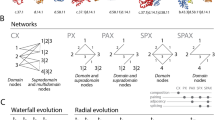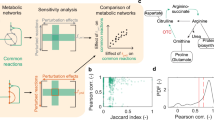Abstract
During evolution different genes evolve at unequal rates, reflecting the varying functional constraints on phenotype. An important contributor to this variation is genetic buffering, which reduces the potential detrimental effects of mutations. We studied whether gene duplication and redundant metabolic networks affect genetic buffering by comparing the evolutionary rate of 242 human and mouse orthologous genes involved in metabolic pathways. A gene with a redundant network is defined as one for which the structural layout of metabolic pathways provides an alternative metabolic route that can, in principle, compensate for the loss of a protein function encoded by the gene. We found that genes with redundant networks evolved more quickly than did genes without redundant networks, but no significant difference was detected between single-copy genes and gene families. This implies that redundancy in metabolic networks provides significantly more genetic buffering than do gene families. We also found that genes encoding proteins involved in glycolysis and gluconeogenesis showed as a group a distinct pattern of variation, in contrast to genes involved in other pathways. These results suggest that redundant networks provide genetic buffering and contribute to the functional diversification of metabolic pathways.
This is a preview of subscription content, access via your institution
Access options
Subscribe to this journal
Receive 12 print issues and online access
$209.00 per year
only $17.42 per issue
Buy this article
- Purchase on Springer Link
- Instant access to full article PDF
Prices may be subject to local taxes which are calculated during checkout


Similar content being viewed by others
References
Ohno, S. Evolution by Gene Duplication (Springer, Heidelberg, 1970).
Walsh, J.B. How often do duplicated genes evolve new functions? Genetics 139, 421–428 (1995).
Force, A. et al. Preservation of duplicate genes by complementary, degenerative mutations. Genetics 151, 1531–1545 (1999).
International Human Genome Sequencing Consortium. Initial sequencing and analysis of the human genome. Nature 409, 860–921 (2001).
Venter, J.C. et al. The sequence of the human genome. Science 291, 1304–1351 (2001).
Lenski, R.E., Ofria, C., Collier, T.C. & Adami, C. Genome complexity, robustness and genetic interactions in digital organisms. Nature 400, 661–664 (1999).
Jeong, H., Tombor, B., Albert, R., Oltvai, Z.N. & Barabasi, A.L. The large-scale organization of metabolic networks. Nature 407, 651–654 (2000).
Thomas, J.H. Thinking about genetic redundancy. Trends Genet. 9, 395–399 (1993).
Pickett, F.B. & Meeks-Wagner, D.R. Seeing double: appreciating genetic redundancy. Plant Cell 7, 1347–1356 (1995).
Michal, G. G. Biochemical Pathways: An Atlas of Biochemistry and Molecular Biology (John Wiley and Sons, New York, 1999).
Reder, C. Metabolic control theory: a structural approach. J. Theor. Biol. 135, 175–201 (1988).
Hirsh, A.E. & Fraser, H.B. Protein dispensability and rate of evolution. Nature 411, 1046–1049 (2001).
Makalowski, W. & Boguski, M.S. Evolutionary parameters of the transcribed mammalian genome: an analysis of 2,820 orthologous rodent and human sequences. Proc. Natl Acad. Sci. USA 95, 9407–9412 (1998).
Wagner, A. Robustness against mutations in genetic networks of yeast. Nature Genet. 24, 355–361 (2000).
Wagner, A. Decoupled evolution of coding region and mRNA expression patterns after gene duplication: implications for the neutralist-selectionist debate. Proc. Natl Acad. Sci. USA 97, 6579–6584 (2000).
Schuster, S., Dandekar, T. & Fell, D.A. Detection of elementary flux modes in biochemical networks: a promising tool for pathway analysis and metabolic engineering. Trends Biotechnol. 17, 53–60 (1999).
Rutherford, S.L. & Lindquist, S. Hsp90 as a capacitor for morphological evolution. Nature 396, 336–342 (1998).
Remold, S.K. & Lenski, R.E. Contribution of individual random mutations to genotype-by-environment interactions in Escherichia coli. Proc. Natl Acad. Sci. USA 98, 11388–11393 (2001).
Ogata, H. et al. KEGG: Kyoto Encyclopedia of Genes and Genomes. Nucleic Acids Res. 27, 29–34 (1999).
Rebhan, M., Chalifa-Caspi, V., Prilusky, J. & Lancet, D. GeneCards: a novel functional genomics compendium with automated data mining and query reformulation support. Bioinformatics 14, 656–664 (1998).
Rivera, M.C., Jain, R., Moore, J.E. & Lake, J.A. Genomic evidence for two functionally distinct gene classes. Proc. Natl Acad. Sci. USA 95, 6239–6244 (1998).
Thompson, J.D., Higgins, D.G. & Gibson, T.J. CLUSTAL W: improving the sensitivity of progressive multiple sequence alignment through sequence weighting, position-specific gap penalties and weight matrix choice. Nucleic Acids Res. 22, 4673–4680 (1994).
Nei, M. & Gojobori, T. Simple methods for estimating the numbers of synonymous and nonsynonymous nucleotide substitutions. Mol. Biol. Evol. 3, 418–426 (1986).
Kimura, M. A simple method for estimating evolutionary rates of base substitutions through comparative studies of nucleotide sequences. J. Mol. Evol. 16, 111–120 (1980).
Kumar, S., Tamura, K., Jakobsen, I.B. & Nei, M. MEGA2: molecular evolutionary genetics analysis software. Bioinformatics 17, 1244–1245 (2001).
Lynch, M. & Conery, J.S. The evolutionary fate and consequences of duplicate genes. Science 290, 1151–1155 (2000).
Wright, F. The 'effective number of codons' used in a gene. Gene 87, 23–29 (1990).
Comeron, J.M. & Aguade, M. An evaluation of measures of synonymous codon usage bias. J. Mol. Evol. 47, 268–274 (1998).
Tajima, F. Simple methods for testing the molecular evolutionary clock hypothesis. Genetics 135, 599–607 (1993).
Bairoch, A. & Apweiler, R. The SWISS-PROT protein sequence database and its supplement TrEMBL in 2000. Nucleic Acids Res. 28, 45–48 (2000).
Acknowledgements
We thank E. Eichler and S. Rutherford for comments on a draft of this manuscript and J. Bailey and M. Johnson for assistance with the computational analysis. This work was supported by a grant from the US National Institutes of Health and a gift from the Charles B. Wang Foundation.
Author information
Authors and Affiliations
Corresponding author
Ethics declarations
Competing interests
The authors declare no competing financial interests.
Rights and permissions
About this article
Cite this article
Kitami, T., Nadeau, J. Biochemical networking contributes more to genetic buffering in human and mouse metabolic pathways than does gene duplication. Nat Genet 32, 191–194 (2002). https://doi.org/10.1038/ng945
Received:
Accepted:
Published:
Issue Date:
DOI: https://doi.org/10.1038/ng945
This article is cited by
-
Environmental flexibility does not explain metabolic robustness
npj Systems Biology and Applications (2020)
-
Standing genetic variation and compensatory evolution in transgenic organisms: a growth-enhanced salmon simulation
Transgenic Research (2011)
-
Use of genetic markers and gene-diet interactions for interrogating population-level causal influences of diet on health
Genes & Nutrition (2011)
-
Networked buffering: a basic mechanism for distributed robustness in complex adaptive systems
Theoretical Biology and Medical Modelling (2010)
-
Evolution of Dopamine-Related Systems: Biosynthesis, Degradation and Receptors
Journal of Molecular Evolution (2010)



